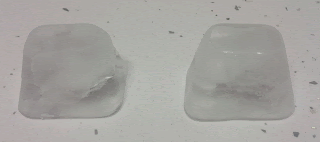The melting point of a solid is the temperature at which it changes state from solid to liquid at atmospheric pressure. When considered as the temperature of the reverse change from liquid to solid, it is referred to as the freezing point.
The freezing point of a solvent is depressed when another compound is added, meaning that a solution has a lower freezing point than a pure solvent. This phenomenon is used in technical applications to avoid freezing, for instance by adding salt or ethylene glycol to water. If you live in a place that has lots of snow and ice in the winter, then you have probably seen the highway department spreading salt on the road to melt the ice.
Now, let us consider the following experiment:
- Make two almost identical ice cubes.
- Mix 1 teaspoon of salt in an 8 oz. cup of water. This will be our salt water cup.
- Fill a 8 oz. cup with water, but with no salt added. This will be our fresh water cup
- Place one ice cube into each cup simultaneously. Which ice cube do you predict would melt the fastest?
Naively, one would think that, according to the previous information, since salt lowers the freezing/melting point of water, the ice cube in the salt water cup should melt the fastest.
Nevertheless, if you carry out the experiment, it leaves no doubt. The ice cube in the fresh water cup melts faster!
Why do ice cubes melt slower in salt water? Please, explain your reasoning. You can post your attempted answers in the comment box below. Please, do not use Facebook or Twitter to give your answers.
I will give you a clue: repeat the experiment, but this time, after you place the ice cubes in the cups, wait 30 seconds and add a couple of drops of food coloring to each cup without disturbing the water in the cups.

You have said that salt lowers the freezing point, but it might be that waters is able to stay liquid even below the freezing point.
ReplyDeleteCold
DeleteThis comment has been removed by the author.
ReplyDeleteIf we repeat the experiment by using food colouring it is easy to see that there is a difference between the density of each cup: the fresh water cup has the colouring expanded throughout the whole cup, meanwhile, the one with the salt water mantains the food colouring on the top of it.
DeleteBy touching both cups, we can observe that in the fresh water cup, the temperature becomes colder in the bottom, so the water on the top of the cup is "hotter" than on the bottom (it is similar to the "convection currents" of the air), this makes the ice melt faster than in the salt water cup, in which the top of the cup feels cold whereas the bottom still retains a warm temperature. The salt water "blocks" the heat from the bottom, and helps the ice cube to keep cold
Very good Pablo!
DeleteWhen we put the ice cube in the fresh water cup, the warmer room-temperature water begins to heat it up. The ice cubes begins to melt, adding cold fresh water to the cup. This cold water is denser than the room-temperature water in the rest of the cup and so it sinks to the bottom of the cup, while the room temperature water at the bottom of the cup moves up toward the surface. As a result, we have convention currents in the cup that can be seen by adding food coloring. Due to these convention currents, the ice cube floating at the top is always been surrounded by new room-temperature water. Consequently, the ice melts faster.
When you place the ice cube in the salt water cup, it also beging to melt and adds cold freesh water to the cup, but in this case the cold fresh water does not sink to the bottom because fresh water, regardless of its temperature, is always less dense than salt water. This cold fresh water surrounds the ice cube and insulates it. By adding food coloring you can see that there are not convenction currents that would make the the melting process be faster (see picture). Therefore, the ice cube melts more slowly in salt water.
This is a very useful cognitive conflict in order to motivate students to learn about the convection currents in freshman and sophomore years (9th and 10th grades).